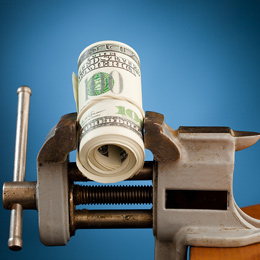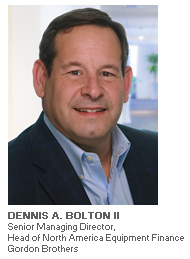
Equipment inventory across multiple industries is being impacted as companies hold back on returning leased assets and delay replacement and expansion cycles amid tariff uncertainty. Dennis A. Bolton II, Senior Managing Director, Head of North America Equipment Finance at Gordon Brothers, meets with Michael Toglia, Publisher of Equipment Finance Advisor to discuss current market conditions and how companies can best navigate the used equipment market.
Michael Toglia: Equipment inventory across multiple industries is hitting critical lows as companies hold back on returning leased assets and delay replacement and expansion investment amid tariff uncertainty. From your perspective at Gordon Brothers, what are the primary drivers behind this hoarding behavior, and how much of it is directly attributable to "tariff uncertainty" versus other factors?

Dennis Bolton: Tariffs have created significant uncertainty which is problematic when managing any business; you would rather make a bad decision based on certainty of information than be paralyzed by not having a basis for confidence in your decisions. Tariffs are causing two behaviors: the first is paralysis as people just do not know what to do and are uncertain about what is coming, so they put these decisions on hold, and the second is haste. Everyone acts very quickly to avoid the unknown and bases their actions on what they currently know before the changes are implemented. It is a terribly complex topic when you think about all the variables involved with tariffs and their impact on businesses. I think it is very similar to the COVID-19 pandemic.
When the pandemic hit, nobody knew what to do. Supply chains were stretched and everyone started holding onto what they had, and I think there will be a fair number of people holding onto assets now, which will result in reduced inventories. From my perspective, the best example of haste is the front running you saw going on earlier this year. The administration announced these tariffs, and everyone rushed to order everything they could from China and other counties to get delivery before the tariffs took effect. As a result, inventories on the consumer side are high and this spills over into demand. This is not a normal market forces issue, but rather an extraordinary external issue being brought on by regulation.
Anytime regulation creates confusion, it makes it very hard to decide not only what to do if you are buying new equipment or if you are holding on to used equipment, but also how you value it. If you have a $100,000 foreign machine that is subject to a 100% tariff, that machine now costs $200,000. That is fine if the tariff stays in place. However, if the tariff gets repealed you are now into a machine for two times the cost, and if it drops back to $100,000, you have a big problem with impairment.
I also believe you will see switching between new and used equipment as well as switching between manufacturers. If the best machine you can buy is a German machine, then as opposed to paying whatever the tariff is coming out of Germany, if there is a lower tariff coming out of Mexico, then the decision to buy the Mexican machine over the German machine is more appealing.
Toglia: Are there particular industries where this "equipment squeeze" is more pronounced, or conversely, industries that are unaffected? What trends are you observing in those specific sectors?
Bolton: Certainly. Industries where the primary equipment manufacturers are foreign are going to be negatively impacted. When you look at machine tools built in Japan, Korea and Germany, those will be impacted. But it is not just the manufacturer. Take for example Caterpillar or GM or even Boeing. In these cases, you must look at the supply chains and the components coming in to build the machinery. If the components are subject to tariffs, the cost of the overall assembled product is impacted. For now, I think most companies are going to delay investment decisions as long as they can. I believe you will see activity in the used equipment market pick up for this reason because the likely decision will be to purchase a used machine and use it until the company determines it can purchase a new one. And if a company has excess capacity, they must determine if it would be best to hold capacity steady at this time.
The other overarching issue is what is happening on the inflationary and the recessionary side of the macroeconomic scene. Everyone has been forecasting GDP growth of 2.5% to 3.5%, so when a business leader considers expanding into other product lines, the question is whether they should increase their overall capacity. The issue is that tariffs are putting a drag on GDP.
Just think about it on the renewable side. When you are talking about offshore wind for example, just think of all the vessels and cranes required to erect these structures – very large, very expensive and specialized units. If you have a 10-year runway versus a three-year runway to make that investment, you can see how it would impact the investment decision.
Toglia: With companies delaying replacement cycles, what impact is this having on the valuation and appraisal of older equipment, and how does Gordon Brothers adjust its methodologies in such a market?
Bolton: The market is going to adjust this for us. There are three approaches used to value equipment: the cost approach, the market approach and the income approach. For equipment, the income approach is not typically used unless it is something such as a power plant. Of the other two approaches, the cost approach is simple. What does a new machine cost? How much depreciation must come out of the machine to adjust its value down?
The third approach is the market approach. If I am dealing with XYZ company, the manufacturer of ABC model, the question is: Have any of these pieces of equipment sold in the market? What you are going to see over time is inflationary pressures on both auction and third-party comps will be visible in the marketplace.
What becomes important is the reconciliation, the weighting and how you reconcile those two approaches. For example, if I have a cost approach value for a piece of equipment of $100,000, and a market approach value of $80,000, I would probably weigh the market side much more heavily than the cost side. But it is still relevant because it brackets the value range in some manner and provides insight into where values could be going considering inflationary or deflationary pressures.
Toglia: Is there a strategy you recommend that companies seeking to acquire equipment should employ to navigate this environment?
Bolton: You are going to see this drive companies to the lease market. What could be a better strategy than optionality? Companies can mitigate the risk of paying 30% more for a piece of equipment that has a 10-year life if they have the option to buy or return, depending on what happens in the future with tariffs. The optionality provides a high level of certainty.
Toglia: So, a strategy is to utilize leasing products. Is there anything else that could be done?
Bolton: Yes, I would suggest buying used equipment or looking to lease or rent equipment. I would also recommend taking a hard look at how critical expansion or replacement is, especially in the context of the macroeconomic environment. Companies should ask themselves: Do I truly believe GDP is going to continue to grow? Can I make enough money to offset the risk associated with this investment? It all comes down to economics and the modeling of your assumptions.
Toglia: Is there a pull towards renting right now and if there is, aren’t the rental companies in the same boat when they need to acquire equipment?
Bolton: The dynamic is very similar. I know some people in the rental market, and they are looking for whatever equipment they can buy that is used. The rental market is different than the leasing market because it is more of a full-service model. It is a different perspective, but I think a lot of the primary themes are going to be the same. You are going to see people switch to domestic manufacturers and you are going to see them look to the used equipment market.
Toglia: Besides the tariffs, are there other economic indicators you feel that equipment buyers should consider now?
Bolton: The other thing I always look at is the cost of inputs. For example, the big question mark is steel. The U.S. Steel-Nippon deal went through, and it has been reported Nippon Steel Corporation is putting in six electric furnaces and expanding further. But it is unclear if sufficient steel can be produced to supply what is needed domestically. The pandemic was a great example. During this period, the cost of scrap steel went from $400 or $450 per ton to well over $1,000 per ton. The degree of impact from these rising costs is heavily determined by the percentage of product produced by U.S. companies versus foreign manufacturers and cost to deliver.
Toglia: From your perspective, is the private credit market having an impact on the equipment finance industry?
Bolton: This is one of the most unique times in my 35-year career, and we must now also consider the impact of private credit. When you look at the growth in private credit, you can see a shift in lending criteria. When I started my career, there were independent operating lessors such as GE Capital, Itel and Westinghouse, as well as financial lessors, including the banks all seeking market share. Almost all of these independents, such as GE Capital, went away. Private credit and private equity have changed the complexion of the market and has shifted the way companies are financed. Historically, lenders and lessors had very linear product sets including leasing products, asset-based loans and term loans. I think private credit led by Gordon Brothers on the equipment finance front is creative in providing a more comprehensive solution that best meets the customer’s needs.
We are relationship driven and committed to supporting companies and their leadership team as partners. Our goal is to contribute meaningful value at every stage of the process, whether that means working together long term or helping companies transition to traditional financing when the time is right. We measure our success by the strong partnerships we build and ongoing trust our clients place in us.